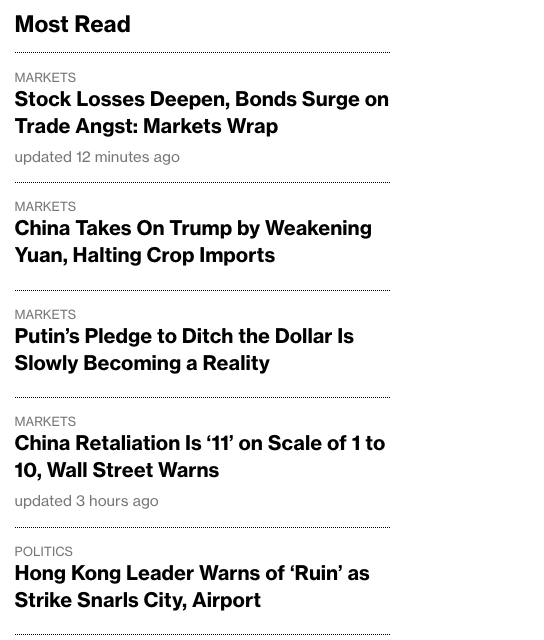There’s nothing wrong with central banks paying negative interest rates on bank reserves. There is something very wrong with a monetary regime that causes equilibrium nominal interest rates to end up negative. That’s one way of thinking about my recent Econlog post.
Yahoo has an interesting article on negative interest rates:
“Rising life expectancy increases desired saving while new technologies are capital-saving and are becoming cheaper – and thus reduce ex ante demand for investment,” Fels writes. “The resulting savings glut tends to push the ‘natural’ rate of interest lower and lower.”
The disinflationary impact of technology is something that many economists and policymakers have argued is keeping a lid on inflation and, in turn, interest rates. Federal Reserve chair Jerome Powell, for instance, said in May that, “Today’s inflation dynamics are very different from even 25 years ago. Globalization and technology may be playing a role.”
These two paragraphs sound similar, but there are important differences. Powell seems to be suggesting that globalization and technology reduce inflation by boosting aggregate supply. That could happen, but in fact aggregate supply has done poorly in recent years, so there is no way that the supply side of the economy can explain the recent low rates of MEASURED inflation. BTW, I don’t even consider this a debatable point; so don’t respond with irrelevant claims such as the theory that ACTUAL inflation may be lower than measured.
Fels’ comments are more interesting, albeit also wrong in an important way. I suspect that he has correctly zeroed in on two of the key factors that are depressing real interest rates throughout the world.
People often talk about “population growth”, but that clearly doesn’t explain inflation. Venezuela may have the world’s lowest population growth at the moment, and last time I checked they were not experiencing deflation. Fels is right that the aging population is more likely the key issue. Middle-aged people now expect to live a long time, and they are willing to save money at even negative rates of interest:
Longer life expectancy, in Fels’ view, also contributes to lower inflation as longer-living savers have a “negative time preference,” meaning they prepare for future, rather than present, consumption. And all else equal, fewer people spending less money in the present will keep prices flat or falling as demand does not pressure supply.
“Once upon a time, economic theory maintained that people always value today’s consumption more than tomorrow’s consumption – and thus display positive time preference,” Fels writes.
“People would therefore always demand compensation in the form of a positive interest rate in order to forgo current consumption and save for the future instead. People were viewed as impatient, and the more impatient people are, the higher the interest rate has to be to make them save.”
But this is not the world we live in now.
He’s wrong about how this impacts “demand” (which is determined by monetary policy), but I suspect he’s right about the causes of ultra-low interest rates.
So if demographic trends causing more saving don’t lead to lowflation, what does? The answer is simple: monetary policy.
So then why do low inflation rates correlated with low real interest rates and also with aging demographics? That’s a harder question.
One possibility is that the correlation is explained by some central banks making the foolish decision to target interest rates. Just look at the yen, where this is especially obvious. Almost every time there’s a negative shock to the global economy that depresses the real interest rate, the yen appreciates and Japan falls further from its 2% inflation target. The mainstream media claims this is due to people all over the world being engaged in a “flight to safety”, which doesn’t even pass the laugh test. Why would Japan be a safe haven? The yen even appreciates if the shock in question hits Japan itself:
Concerns about the impact of Japan’s earthquake and tsunami on the global economy intensified on Thursday as the yen surged and shares in Tokyo suffered further losses.
That’s right, mainstream economists would have you believe that a tsunami that destroyed out a big chuck of Japan’s industry, and that led to a shutdown of its nuclear power industry (supplying 30% of their electricity), led investors all over the world to seek a “safe haven” by putting their money into . . . Japan!?!?!?!?!
Yeah, that’s why the yen appreciated.
And notice that this surge of money seeking safety in Japan somehow failed to boost Japanese stock prices, which collapsed as the yen surged higher.
There’s a much simpler explanation. The Japanese central bank targets interest rates. When the equilibrium rate falls, monetary policy gets tighter and the yen appreciates. This has nothing to do with Japan being a “safe haven”.
Mainstream economists will tell you that Trump’s tariffs are inflationary. In fact, if they reduce the equilibrium interest rate and the Fed doesn’t respond appropriately, then the tariffs will be deflationary. Just as Smoot-Hawley was deflationary.
If you want to understand inflation, you need to understand monetary policy.
So what should the world do about negative interest rates? Set a NGDP level target at a high enough rate to push nominal rates above zero. There is no substitute. Japan tried massive fiscal stimulus in the 1990s and 2000s, and it completely failed.
The Fed is paying more attention to markets than they used to, but still nowhere near as much attention as they should. It’s depressing to see Fed officials discuss “long and variable lags”, which is 20th century thinking. Right now markets are telling us that monetary policy is too tight to hit the Fed’s inflation target. If they are worried about negative interest rates then they need to sharply cut their interest rate target, ASAP.
Rates are going to fall either way. It’s better they fall with an expansionary monetary policy than a contractionary monetary policy. Right now it looks like the latter.



